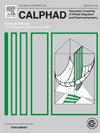由从头算分子动力学模拟得到的三元液体合金的部分径向分布函数估计三元液体合金的组分活度
IF 1.9
3区 材料科学
Q4 CHEMISTRY, PHYSICAL
Calphad-computer Coupling of Phase Diagrams and Thermochemistry
Pub Date : 2025-08-05
DOI:10.1016/j.calphad.2025.102864
引用次数: 0
摘要
溶液热力学模型的关键二元参数通常由二元溶液的实测活度数据确定,进而预测相应三元甚至多组分溶液的热力学性质。然而,在缺乏实验数据的情况下,目前可靠地确定这些参数仍然是困难和具有挑战性的。本文通过从头算分子动力学(AIMD)模拟得到了9种二元液态合金的部分径向分布函数(PRDF)。基于物理量的统计平均原理,正确推导了带PRDF的流体分子平均对势能的简化表达式。然后将其与常规溶液模型(RSM)、Wilson方程、非随机双液方程(NRTL)和分子相互作用体积模型(MIVM)的二元模型参数进行关联,确定其值。在此基础上,对9种二元和4种三元液态合金体系的组分活度进行了估计,并与拟合参数法和Miedema模型得到的组分活度进行了比较。结果表明:对于9种二元合金体系,采用对称PRDF方法时,Wilson方程的标准差(SD)和平均相对偏差(ARD)分别为0.073和25%;采用非对称PRDF方法时,RSM的SD和ARD分别为0.067和15%;采用拟合参数法时,Wilson方程的SD和ARD分别为0.016%和4%;采用Miedema模型时,SD和ARD分别为0.090和35%。对于4种三元合金体系,采用对称方法时,Wilson方程的SD和ARD分别为0.068和16%;采用非对称方法时,RSM的SD和ARD分别为0.061%和14%;采用拟合参数法时,MIVM的SD和ARD分别为0.028和6%;采用Miedema模型和Toop模型的联合方法时,其SD和ARD分别为0.052和13%。这表明,在没有二元液态合金活度实验数据的情况下,利用与PRDF相关的APPE简化表达式可以获得估算三元甚至多组分液态合金所有组分活度的热力学模型的关键二元参数。本文章由计算机程序翻译,如有差异,请以英文原文为准。
Estimation of component activities of ternary liquid alloys by partial radial distribution functions of binary liquid alloys obtained from ab initio molecular dynamics simulation
The key binary parameters of solution thermodynamic models are usually determined by the measured activity data of binary solutions, and then thermodynamic properties of the relevant ternary or even multi-component solutions can be predicted. However, in the absence of experimental data, it is currently still difficult and challenging to determine these parameters reliably. In this paper, the partial radial distribution functions (PRDF) of 9 binary liquid alloys are obtained by ab initio molecular dynamics (AIMD) simulation. Based on the statistical average principle of physical quantities, a simplified expression of the average pair potential energy (APPE) of fluid molecules with PRDF is correctly derived. Then it can be correlated with the binary model parameters of the Regular Solution Model (RSM), the Wilson equation, the Non-Random Two-Liquid equation (NRTL), and the Molecular Interaction Volume Model (MIVM), and their values are determined. Based on this, the component activities of the 9 binary as well as the 4 ternary liquid alloys systems were estimated and compared with those obtained by the fitting parameter method and the Miedema model. The results show that for the 9 binary alloys systems, when the symmetric PRDF method is used, the standard deviation (SD) and the average relative deviation (ARD) of Wilson equation are 0.073 and 25 % respectively; when the asymmetric PRDF method is used, the SD and ARD of RSM are 0.067 and 15 %; when the fitting parameter method is used, the SD and ARD of Wilson equation are 0.016 and 4 %; when the Miedema model is used, its SD and ARD are 0.090 and 35 %, respectively. For the 4 ternary alloys systems, when the symmetric method is used, the SD and ARD of Wilson equation are 0.068 and 16 % respectively; when the asymmetric method is used, the SD and ARD of RSM are 0.061 and 14 %; when the fitting parameter method is used, the SD and ARD of MIVM are 0.028 and 6 %; when the combined method of the Miedema model and the Toop model is used, its SD and ARD are 0.052 and 13 %, respectively. This indicates that the simplified expression of APPE related with PRDF can be used to obtain the key binary parameters of some thermodynamic models for estimating all component activities of ternary or even multi-component liquid alloys in the absence of activity experimental data of binary liquid alloys.
求助全文
通过发布文献求助,成功后即可免费获取论文全文。
去求助
来源期刊
CiteScore
4.00
自引率
16.70%
发文量
94
审稿时长
2.5 months
期刊介绍:
The design of industrial processes requires reliable thermodynamic data. CALPHAD (Computer Coupling of Phase Diagrams and Thermochemistry) aims to promote computational thermodynamics through development of models to represent thermodynamic properties for various phases which permit prediction of properties of multicomponent systems from those of binary and ternary subsystems, critical assessment of data and their incorporation into self-consistent databases, development of software to optimize and derive thermodynamic parameters and the development and use of databanks for calculations to improve understanding of various industrial and technological processes. This work is disseminated through the CALPHAD journal and its annual conference.

 求助内容:
求助内容: 应助结果提醒方式:
应助结果提醒方式:


